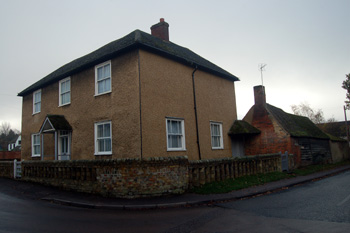
9 Grange Street November 2009
9 Grange Street is a substantial farmhouse belonging to Pedley Farm. In the early 18th century Pedley's Farm seems, to judge by later deeds [Z1354/1], to have been put together by George Byng, 1st Viscount Torrington, who bought land from Edward Rudd, Mary Lee, and John Pedley, amongst others and by his son Pattee, 2nd Viscount Torrington who bought from John Matthews, Elizabeth Matthews and Sir Wolstan Pirie. The farm was, with other property settled in trustees by George, 3rd Viscount Torrington, in 1747. It then comprised:
- a four acre close with a dovehouse adjoining the house;
- The Butts of one acre;
- 5 acres, 9 poles of meadow in Stanford Holme;
- 25 poles of meadow in Brook Furlong;
- 2 roods of meadow in Hilliford;
- 7½ acres of meadow in Green Knoles.
The farm was then occupied by William Lyles. Later in the century the farm was purchased by Richard Astley of Southgate [Middlesex]. He devised it in his will to William Yates of Edmonton [Middlesex], who devised it in his will to John Yates of Market House Square, London. Yates conveyed the farm to Robert Henley Ongley of Old Warden in 1797. The farm then contained the following land:
- the farm house and a close of pasture adjoining called Home Close;
- a close or pyghtle of pasture called Butts Close containing one acre;
- 11 acres and 20 perches of Lammas Meadows or pasture ground called by the several names Further Greenhill, Rush Mead and Round Mead;
- 4 acres and 24 perches of common meadow ground called the Hurlefer, Stanford Holme, Pan Acre and Brook Mead;
- 30 acres and 20 perches in Shefford Field;
- 12 acres and 2 roods in How Field;
- 33 acres, three roods and 7 perches in Hitchin Field;
- 10 acres, 1 rood and 21 perches in Little Field;
- 20 acres, 1 rood and 10 perches in East Field.
The farm was previously in the occupation of Sarah Syles but by 1797 in the occupation of John Arth.
Nearly a hundred years later, in 1893 Pedley's Farm was put up for sale by auction. The farm house was described as a stud-built and tiled "comfortable roomy dwelling-house" on a brick underpinning "standing at the corner of the High Road and Pedley's Lane with entrances from same, Garden in front, well protected from the Road by dwarf brick wall". The house contained a "good sunk cellar", entrance hall, dining, drawing and breakfast rooms, kitchen, pantry, staircase and six bedrooms. A two roomed cottage was "under the same roof, having frontage to Pedley's Lane". The pebbled yard at the back of the farm house contained a "well of excellent water" and a brick, timber and tile brewhouse.
The Rating and Valuation Act 1925 specified [Section 19 (1)] that every piece of land and property in the country be valued to determine the rateable value. Clifton, like most of Bedfordshire, was assessed in 1927 and the valuer visiting 9 Grange Street [DV1/C220/1] noted that it was part of Pedley Farm, owned by Sandy Building Society as mortgagee of H. G. Watts. The "old" house stood in just under an acre and was "Really a farm house" comprising a porch, two parlours, a living room, kitchen and pantry downstairs with five bedrooms and a bathroom upstairs. A wood and tile washhouse and barn stood outside along with two further wood and tile barns. Water was laid on to the premises.
The homestead, standing in 0.321 of an acre, comprised a number of buildings and ranges of buildings. These comprised:
- A wood and tile tool house and three bay barn ("has been used for hens");
- A large wood and thatch used for pigs;
- A wood and tile chaff house, root house and three stall stable in a large barn; a five bay open cart shed and a hen house;
- A wood and thatch calf house;
- A wood and tile loose box, cow house for five beasts with a cement floor, two loose boxes (one "useful") and two pigsties.